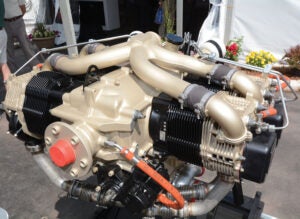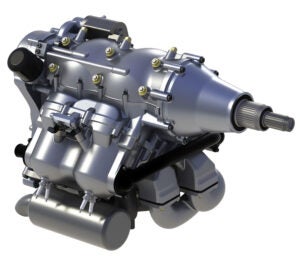
Continental
Thanks to their complex and high-pressure nature, diesel (Jet A) burning piston engines are premium devices full of expensive parts, and their penetration into the Amateur-Built world is essentially nil no matter the manufacturer. Some sophisticated, powerful and very fuel-efficient Jet A reciprocating engines have been developed, but their newness and high initial cost mean they’ve barely penetrated the military drone market to date.

Meanwhile, Continental has a surprising well-populated line of certified diesels as they’ve bought diesel programs started by Thielert, Austro Engine and other European outfits. At least technically, these engines are suited to larger homebuilt aircraft (they’ve been used on Cessna 182s, for example). But their economics make them viable only after flying many hours, not the typical sport plane operating profile.
Higgs Diesel
Besides the liquid-cooled Lycoming conversions, the new AC Aero USA LLC is also offering complete, clean-sheet designs under the Higgs Diesel banner.

These engines center on another of Andrew Higgs’ liquid-cooled cylinder concepts combining attributes of both two- and four-stroke operation. The central concept is a two-stroke engine breathing through ports (no traditional poppet valves or valve train) with radically different piston/pumping units that, among other things, seal the crankcase from the combustion chamber resulting in full pressure oiling to the bottom end. The result is very vertically compact, valveless engines with a conventional spark ignition system burning almost any fuel—but designed for Jet A. Yes, it burns Jet A using spark plugs. Higgs lists six varieties of upright and inverted-V configurations, ranging from sensible 115-hp V-4s up to a rousing V-12 boasting well over 1000 hp. All these engines claim excellent power-to-weight characteristics, as expected from what is essentially a two-stroke engine.
These Higgs Diesel designs have been promoted previously in computer-drawn form and were featured in previous years of this buyer’s guide. But they’ve yet to be seen in the metal, something Higgs says will change in very early 2021 as the necessary parts were being built in Japan as we went to press.
| Engine Model | Drive Type | Horsepower | Weight | Price |
|---|---|---|---|---|
| Continental Motors | ||||
| CD-135 | geared | 135 hp @ 3890 rpm | 295.4 lb with accessories, dual FADEC | Kit program only |
| CD-155 | geared | 155 hp @ 3890 rpm | 295.4 lb with accessories, dual FADEC | Kit program only |
| CD-230 | direct | 235 hp @ 2200 rpm | 450 lb with accessories | Beta program |
| Higgs Diesel | ||||
| Swift FL150J/G | geared | 115 hp @ 5300 rpm | 147 lb, inverted V-4 | $25,000 |
| Swift FL150J/G-T | geared | 130 hp @ 5300 rpm | NA, inverted V-4 | |
| Falcon FL200J/G | geared | 210 hp @ 5300 rpm | 165 lb, inverted V-4 | $45,000 |
| Falcon FL200J/G-T | geared | 250 hp @ 5300 rpm | 205 lb, inverted V-4 | $60,000 |
| Hawk E330J/G | geared | 350 hp @ 5300 rpm | 306 lb, upright V-4 | $58,000 |
| Hawk E330J/G-T | geared | 500 hp @ 5300 rpm | 339 lb, upright V-4 | $78,000 |
| Eagle E660J/G | geared | 650 hp @ 5300 rpm | 512 lb, upright V-8 | $180,000 |
| Eagle E660J/G-T | geared | 800 hp @ 5300 rpm | TBD, upright V-8 | TBD |
| Condor E1000J/G | geared | 1000 hp @ 5300 rpm | 664 lb, upright V-12 | $216,000 |
| Condor E1000J/G-T | geared | 1600 hp @ 5300 rpm | 714 lb, upright V-12 | $260,000 |





I’ve been drooling over the pictures and sparse (very sparse) spec sheets for the Falcon engines on AC-AERO’s website for a while now. From the advertising, the Falcon would be a FABULOUS engine for my Cozy MK IV build, assuming a fairly heavy water cooling system installation and a constant speed 70” prop is swinging wayyyy back there to balance the lighter weight engine than the O-360 nominally set purring beneath the cowling.
Then, reality sets in.
I don’t think that it is very fair when engine makers proclaim outstanding performance specs, provide fabulous CAD drawings of the engines, and an availability in this or that quarter of 202x, when other makers have had physical prototypes on engine stands, even mounted to a kit plane, only to disappear from history (e.g., Gemini). Hell, I could readily point to the MAGNAX electric motor, draw up some beautiful CAD models of a split battery pack that would easily fit within the strakes of a Cozy MK IV with volume to spare, and proclaim that the combined packs will have an installed weight of 325 lbs (including battery and power management), are intended to provide 1 MWHr at 150 kWhr with only 10 cfpm of air cooling at a worst case 110 F ambient, 100 percent humidity, can be fast charged in 20 minutes, and provides no less than 95% capacity over its 50000 charge-discharge cycle life, all for the low, low price of $60k, installed. Anyone can do that. Snake oil salesmen have been doing it for thousands of years.
Really very tired of having what only appears to be R&D projects tantalizingly dangled in front of us with looming availability dates before there’s any tangible evidence that they’ve actually flown, and certainly very tired of hearing that such engine programs will be providing engines within a year…year after year after year after…
I too have been eagerly awaiting tangible evidence of these new engines. I’m still in the early stages of an RV-10 and the HAWK “sounds” like an innovative alternative to the Lycoming standard. Hopefully, AC-Aero can deliver on the hype and put real hardware into use in real-world aircraft long before I’m ready to mount the engine in my RV.